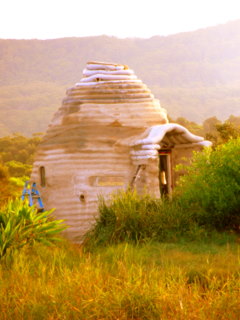 I have now finished my first sand bag dome...well almost. It was a great experience, however lonely, as I moved over 25 tonnes of sand by hand mixed it with cement and put it in the bags myself. I am excitedly happy with the result thus far. The dome was built at a significant Aboriginal heritage site on the beach at Sandon Point south of Sydney, Australia. I have now finished my first sand bag dome...well almost. It was a great experience, however lonely, as I moved over 25 tonnes of sand by hand mixed it with cement and put it in the bags myself. I am excitedly happy with the result thus far. The dome was built at a significant Aboriginal heritage site on the beach at Sandon Point south of Sydney, Australia.
The History Pod 'Murrong Gunya' sand house.
This project was initiated to effect positive and sustainable change in Aboriginal and community housing in Australia. Appropriate housing in remote and bush fire prone areas must be met with sustainable solutions such as earth-bag building. I have built and donated this History Pod dome with respect to Australia's first peoples and the continuation of their Original Sovereignty.
The location of this dome is very close to the beach at a swampy inlet. It is an Aboriginal heritage protection site and an ongoing blockade against unsustainable greedy mansion development that continues to encroach on the unsuitable beachfront swamp. The 'Kuradji' Aboriginal Tent Embassy is a demonstration of land rights and ancient heritage protection that has been acknowledged by the local government and the state of New South Wales. This building project is self-determined requiring no permission or consultation with any purported authority other than the Traditional Owners.
Building
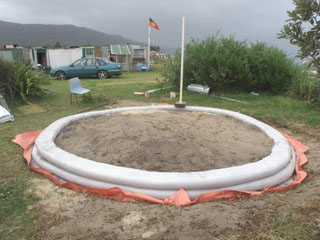 I started this project mid January 2010 by digging the grass and clearing a circle where I dug a trench about a foot deep with a compass chain pegged in ground. This radius chain was cemented in strong, as you don't want it to move during the building process. I put plastic sheet down in the trench to assist in sealing off moisture. I began filling the bags in the trench with moist sand and cement. I started this project mid January 2010 by digging the grass and clearing a circle where I dug a trench about a foot deep with a compass chain pegged in ground. This radius chain was cemented in strong, as you don't want it to move during the building process. I put plastic sheet down in the trench to assist in sealing off moisture. I began filling the bags in the trench with moist sand and cement.
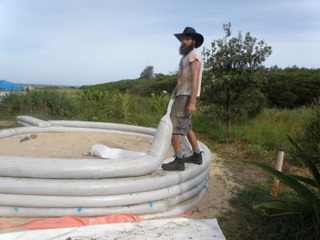 Double the bag over to reduce the length that the bucket of material has to move through the bag tube. The 4m diameter circle was a 14 m length of filled sand bag. The ring is tamped (ram packed) until it is so hard that you can't press it in with your finger. Barbed wire is then attached to the bag ring with a zigzag technique (twisting and skewing the barbs into the bag) ready for another layer directly on top. Double the bag over to reduce the length that the bucket of material has to move through the bag tube. The 4m diameter circle was a 14 m length of filled sand bag. The ring is tamped (ram packed) until it is so hard that you can't press it in with your finger. Barbed wire is then attached to the bag ring with a zigzag technique (twisting and skewing the barbs into the bag) ready for another layer directly on top.
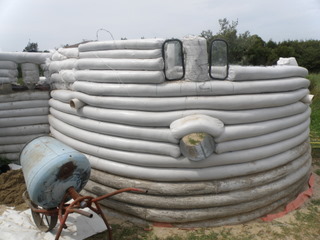 With at least three sub ground layers I needed to make sure the ground and rings are level (foundation). The other chain in the compass system is cemented in at the location of the middle of the door on the outside edge of the bag ring. This length is the diameter in this case 4.2 meters. To get the height of the proceeding layers you use this chain in combination with the radius chain coming from the centre. The position at which the diameter chain (height) which does not change intersects with the radius chain that is adjusted according to the height with a key ring. This gives the position of the circles as you build up and in. With at least three sub ground layers I needed to make sure the ground and rings are level (foundation). The other chain in the compass system is cemented in at the location of the middle of the door on the outside edge of the bag ring. This length is the diameter in this case 4.2 meters. To get the height of the proceeding layers you use this chain in combination with the radius chain coming from the centre. The position at which the diameter chain (height) which does not change intersects with the radius chain that is adjusted according to the height with a key ring. This gives the position of the circles as you build up and in.
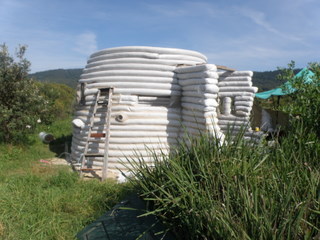 The buttress door needs to be included by interlacing it in with the rings. This works best with a strong door frame form work structure which I didn't have. I had to cut the sand bags with a saw to fit the door frame in. This works surprisingly well and in the future I would intentionally cut areas for windows and leave them in until I was ready to add the windows. The buttress door needs to be included by interlacing it in with the rings. This works best with a strong door frame form work structure which I didn't have. I had to cut the sand bags with a saw to fit the door frame in. This works surprisingly well and in the future I would intentionally cut areas for windows and leave them in until I was ready to add the windows.
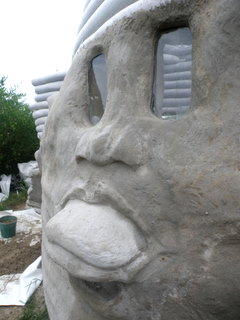 I got a bit experimental with the windows but it all worked out well. Air vents and other additions forms pipes etc. or another level needs to be planned and included as you go. I got a bit experimental with the windows but it all worked out well. Air vents and other additions forms pipes etc. or another level needs to be planned and included as you go.
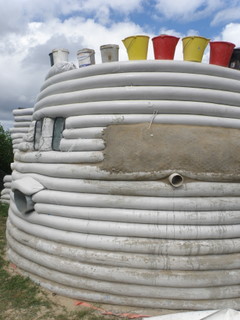 As the wall gets higher it is good to place buckets along the wall before climbing up emptying the bucket and positioning the bag correctly by checking with the chain. As the wall gets higher it is good to place buckets along the wall before climbing up emptying the bucket and positioning the bag correctly by checking with the chain.
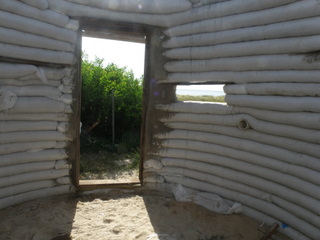 With the door I made a frame with hardwood planks bolted together. This was installed with adjustments made to the sand bags with a saw to fit the frame in nicely. The door jams screwed onto the frame along with the door. With the door I made a frame with hardwood planks bolted together. This was installed with adjustments made to the sand bags with a saw to fit the frame in nicely. The door jams screwed onto the frame along with the door.
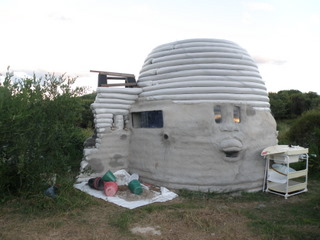 After the height of the door the sand bag rings really start to come in tighter. This can be a bit tricky as I found out when I lost several metres rolling off into the middle. It was like wrestling a giant snake trying to pull a tonne of sand back into position. I ended up having to empty the sand out and do it again. From now on I would get the balance right between twisting and positioning the bag making sure the position of the ring stayed correct by tamping every metre or so as I went. I also started tamping with a hard wood bat at this height because the big metal tamper got a bit heavy and rough (impacted) on the balancing wall. After the height of the door the sand bag rings really start to come in tighter. This can be a bit tricky as I found out when I lost several metres rolling off into the middle. It was like wrestling a giant snake trying to pull a tonne of sand back into position. I ended up having to empty the sand out and do it again. From now on I would get the balance right between twisting and positioning the bag making sure the position of the ring stayed correct by tamping every metre or so as I went. I also started tamping with a hard wood bat at this height because the big metal tamper got a bit heavy and rough (impacted) on the balancing wall.
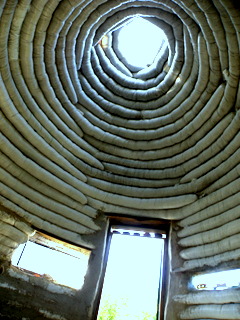 It definitely gets more difficult to keep the circles round as they get smaller finding the balance between twisting a creasing the tube. It definitely gets more difficult to keep the circles round as they get smaller finding the balance between twisting a creasing the tube.
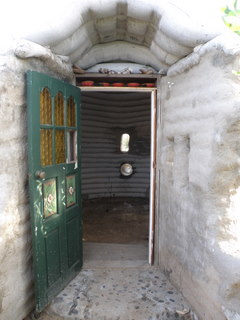 I started rendering on the outside before I closed off the top of the dome. This was to make it easier to get the plaster up the top. I mostly used cement plaster 3:1 3 sand 1 cement. I did try a plaster which was 8 parts sand 1 part lime and .5 part cement mixed with salty sea water. This seemed ok but didn't always go as hard or stable as cement so I went with it. Hopefully it holds up to the extreme sea side elements. I started rendering on the outside before I closed off the top of the dome. This was to make it easier to get the plaster up the top. I mostly used cement plaster 3:1 3 sand 1 cement. I did try a plaster which was 8 parts sand 1 part lime and .5 part cement mixed with salty sea water. This seemed ok but didn't always go as hard or stable as cement so I went with it. Hopefully it holds up to the extreme sea side elements.
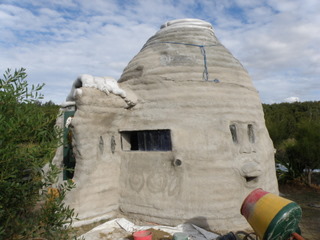 I added more ventilation pipes at the top in an arrangement to tilt the final layer of bag slightly toward the north. I then cemented in the round coffee table top glass to close it off and provide skylight. I have yet to do the plastering on the inside and the floor - probably a cement slab. I will also be doing another coat of render on the outside after seeing what happens with the render I have done over the next few months. If all is well and any cracking is soughed out I will start waterproofing the top firstly by painting on cement and oxides. If this doesn't work I will use a UV treated latex type membrane which is quite expensive and I will need to fundraise for this. I added more ventilation pipes at the top in an arrangement to tilt the final layer of bag slightly toward the north. I then cemented in the round coffee table top glass to close it off and provide skylight. I have yet to do the plastering on the inside and the floor - probably a cement slab. I will also be doing another coat of render on the outside after seeing what happens with the render I have done over the next few months. If all is well and any cracking is soughed out I will start waterproofing the top firstly by painting on cement and oxides. If this doesn't work I will use a UV treated latex type membrane which is quite expensive and I will need to fundraise for this.
The opening of the History Pod at Sandon point is planned for the 17 th December 2010 celebrating the tenth anniversary of the Aboriginal tent embassy and the continued blockade of the developers.
Contact Daniel Jones: dantares13ATgmail.com Mob Australia 0406 025 683/0429 682 069
|